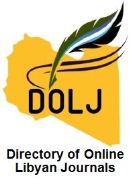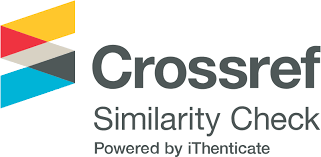أغشية ذات مصفوفة مختلطة مشتقة من بولي إيثيلين عالي الكثافة والنبات الثلجي لفصل صبغة الميثيلين الزرقاء من المحاليل المائية
DOI:
https://doi.org/10.59743/jmset.v10i2.185الكلمات المفتاحية:
بولي إيثيلين عالي الكثافة، تقنية الأغشية، غشاء المصفوفة المختلطة، معالجة مياه الصرف الصناعي، صبغة اليثيلين الزرقاءالملخص
لقد وجد بأن تقنية الأغشية تلعب دورًا مهمًا في تطبيقات معالجة وتنقية المياه مثل معالجة مياه الصرف الصحي وتحلية المياه قليلة الملوحة ومياه البحر. أغشية المصفوفة المختلطة mixed matrix membrane (MMMs) هي فئة جديدة من الأغشية المصنعة عن طريق الجمع بين المواد البوليمرية والمواد النانوية، وهي تقجم حل مستقبلي لتحديات معالجة المياه. عليه، تهدف هذه الدراسة إلى تطوير نوع جديد من أغشية المصفوفة المختلطة (MMMs) من توزيع جسيمات النبات الثلجي Mesembryanthemum crystallinum (MC) في مصفوفة بوليمرية من البولي إيثيلين عالي الكثافة (HDPE). فلقد تم تصنيع ثلاثة أنواع من MMMs، والتي تم تصنيفها وفقًا لمحتوى النسبة الوزنية لكمية MC في العينة: HDPE-SC/MC-0 و HDPE-SC/MC-1 و HDPE-SC/MC-2. حيث تشمل هذه الدراسة خصائص MMMs مثل خاصية المحبّة للماء والمسامية والنفاذية وتدفق الماء النقي. كما تم التحقق من أداء أغشية المصفوفة المختلطة (MMMs) التي تم إنتاجها لفصل صبغة الميثيلين الزرقاء (MBD). ولقد أشارت النتائج إلى أن إضافة 2% من وزن MC لغشاء بولي إيثيلين عالي الكثافة قد أدى إلى تحسين كفاءة فصل صبغة الميثيلين الزرقاء (MBD) بزيادة نسبة الفصل من 42 إلى 60%.
التنزيلات
المراجع
Abushaina, A., Sultan, A., Elhrari, W., and Alhwaige, A. A. (2018). Novel green sorbents derived from Mesembryanthemum-based biomass for wastewater treatment applications. First Conference for Engineering Sciences and Technology (CEST-2018) 25-27 September 2018, Garaboulli, Libya, 345–354.
Ajari, H., Zrelli, A., Chaouachi, B. and Ponti´e, M. (2019). Preparation and characterization of hydrophobic flat sheet membranes based on a recycled polymer. International Polymer Processing, 34(3), 376–382.
Alhwaige, A. A., Ishida, H., and Qutubuddin, S. (2013). Biobased chitosan/polybenzoxazine cross-linked films: preparation in aqueous media and synergistic improvements in thermal and mechanical properties. Biomacromolecules 14, 1806−1815..
Alhwaige, A. A., Ishida, H., and Qutubuddin, S. (2019). Poly (benzoxazine-f-chitosan) films: The role of aldehyde neighboring groups on chemical interaction of benzoxazine precursors with chitosan. Carbohydrate Polymers, 209, 122–129.
Alhwaige, A. A., Ishida, H., and Qutubuddin, S. (2024). Nitrogen-enriched carbon aerogels derived from polybenzoxazine cross-linked graphene oxide-chitosan hybrid matrix with superior CO2 capture performance. ACS Applied Engineering Materials. 2, 1672−1686
Ekrayem, N. A., Alhwaige, A. A., Elhrari W., and Amer, M. (2021). Removal of lead (II) ions from water using chitosan/polyester crosslinked spheres derived from chitosan and glycerol-based polyester. Journal of Environmental Chemical Engineering, 9, 106628.
Ezzeghni, U. A. S., and El-Bourawi, M. S. (2016). Performance improvement and optimization of 10,000 m3/day SWRO desalination plant. First International Conference on Chemical, Petroleum, and Gas Engineering (ICCPGE-2016), Alkhoms, Libya, 1, 25–30.
Figoli, A., and Criscuoli, A. (Eds.). (2017). Sustainable membrane technology for water and wastewater treatment. Green Chemistry and Sustainable Technology, 1–66.
Ghaemi, N., and Khodakarami, Z. (2019). Nano-biopolymer effect on forward osmosis performance of cellulosic membrane: High water flux and low reverse salt. Carbohydrate Polymers, 204, 78–88.
Ghazanfari, D., Bastani, D., and Mousavi, S. A. (2017). Preparation and characterization of poly (vinyl chloride) (PVC) based membrane for wastewater treatment. Journal of Water Process Engineering, 16, 98–107.
Jhaveri, J. H., and Murthy, Z. V. P. (2016). Nanocomposite membranes. Desalination and Water Treatment, 57, 26803–26819.
Katare, A., and Mandal, B. (2023). Green-synthesized HF-free MIL-100 (Fe) nanoparticle-infused chitosan mixed-matrix membranes for enhanced CO2 permeance. Industral & Engineering Chemical Research, 62, 11151−11164.
Lin, C. –H., Gung, C. –H., Sun, J. –J., and Suen, S. -Y. (2014). Preparation of polyethersulfone/plant-waste-particles mixed matrix membranes for adsorptive removal of cationic dyes from water. Journal of Membrane Science, 471, 1, 285–298.
Liu, C., Ma, Z., Zhang, X., Tang, S., Zhu, Z., He, P., Lei, S., Liu, Z., Wang, T., Wang, Y., and Zhang, S. (2024). Separating 2-phenylethanol from aqueous solution by mixed matrix composite membranes based on beta-cyclodextrin metal organic frameworks. Separation and Purification Technology, 330, 125463.
Lloyd, D. R., Kinzer, K. E., and Tseng, H. S. (1990). Microporous membrane formation via thermally induced phase separation. I. Solid-liquid phase separation. Journal of Membrane Science, 52(3), 239–261.
Lok, A., Bérubé, P. R., and Andrews, R. C. (2017). The Effect of Concentration Factor on Membrane Fouling. Membranes, 7, 50.
Mahajan, R., and Koros, W. J. (2004). Mixed matrix membrane materials with glassy polymers. Part 1. Polymer Engineering and Science, 42, 7, 1420–1431.
Nam, Y. S., and Park, T. G. (1999). Biodegradable polymeric microcellular foams by modified thermally induced phase separation method. Biomaterials, 20, 1783–1790.
Roy, S., and Singha, N. R. (2017). Polymeric nanocomposite membranes for next generation pervaporation process: Strategies, challenges and future prospects. Journal of Membrane Technology, 7(3), 53.
Saedi, S., Madaeni, S. S., Seidi, F., Shamsabadi A. A., and Laki, S. (2013). Synthesis and application of a novel Amino-Starch derivative as a new polymeric additive for fixed facilitated transport of carbon dioxide through an asymmetric polyethersulfone (PES) membrane. International Journal of Greenhouse Gas Control 19, 126–137.
Salima, A., Ounissa, K. –S., Lynda, M., and Mohamed, B. (2012). Cationic dye (MB) removal using polymer inclusion membrane (PIMs). Procedia Engineering, 33, 38–46.
Strathmann, H., Giorno, L., and Drioli E. (2016). An Introduction to membrane science and technology. Institute on Membrane Technology CNR-ITM, 1–3.
Swamy, B. V., Madhumala, M., Prakasham, R. S., and Sridhar. S. (2013). Nanofiltration of bulk drug industrial effluent using indigenously developed functionalized polyamide membrane. Chemical Engineering Journal, 233, 193–200.
Tolba, G. M. K., Bastaweesy, A. M., Ashour, E. A., Abdelmoez, W., Khalil, K. A., and Barakat, N. A. M. (2016). Effective and highly recyclable ceramic membrane based on amorphous nanosilica for dye removal from the aqueous solutions. Arabian Journal of Chemistry 9, 2, 287–296.
Qu, X., Alvarez, P. J. J., and Li, Q. (2013). Applications of nanotechnology in water and wastewater treatment. Water Research, 47, 12, 3931–3946.
Wang, J., Dlamini, D. S., Mishra, A. K., Pendergast, M. T. M., and Wong, M. C. Y. (2014). A critical review of transport through osmotic membranes. Journal of Membrane Science, 454, 516–537.
Warsinger, D. M., Chakraborty, S., Tow, E. W., Plumlee, M. H., Bellona, C., Loutatidou, S., Karimi, L., and Mikelonis, A. M. (2018). A review of polymeric membranes and processes for potable water reuse. Progress in Polymer Science, 81, 209–237.
Wetzel, G. W. (2001). Limnology: Lake and River Ecosystems. Academic Press, New York, 15–42.
Wu, Z., Zeng, J., Huang, X., Zhang, R., and Liu, P. (2023). Mixed matrix membranes with highly dispersed UiO-66-NH2 filler for removal of dyes and molybdenum (VI) ions from aqueous solutions. Colloids and Surfaces A: Physicochemical and Engineering Aspects 674, 31959.
Zheng, X., Zhang, Z., Yua, D., Chena, X., Chenga, R., Mina, S., Wanga, J., Xiaoa, Q., and Wang, J. (2015). Overview of membrane technology applications for industrial wastewater treatment in China to increase water supply. Resources, Conservation and Recycling, 105, 1–10.
Zulfiani, U., Junaidi, A., Nareswari, C., Ibnu Ali, B. T., Jaafar, J., Widyanto, A. R., Saiful, Dharmab, H. N. C., and Widiastuti, N. (2023). Performance of a membrane fabricated from high density polyethylene waste for dye separation in water. RSC Advances, 13, 7789–7797.
Zulfiani, U., Pratama, A. W., Abdullah, R., Astira, D., Romadiansyah, T. Q., Widyanto, A. R., Saiful, Jafaar, J., Gunawan, T., and Widiastuti, N. (2024). Improving the performance of HDPE plastic membranes for heavy metal removal by incorporating EVA/PDMS. Results in Engineering, 24, 103643.
Zukimin, N. W., Jullok, N., Razi, A. N. M., and Fadzilah, M. H., Teknol H. (2017), Membrane from plastic waste for the treatment of contaminated river water. Jurnal Teknologi, 79(1-2), 83–88.
الملفات الإضافية
منشور
إصدار
القسم
الرخصة
الحقوق الفكرية (c) 2025 Almahdi A. Alhwaige, Ali N. Al-Drogi, Muammer B. Yahiya, Wael K. Elhrari

هذا العمل مرخص بموجب Creative Commons Attribution-ShareAlike 4.0 International License.











